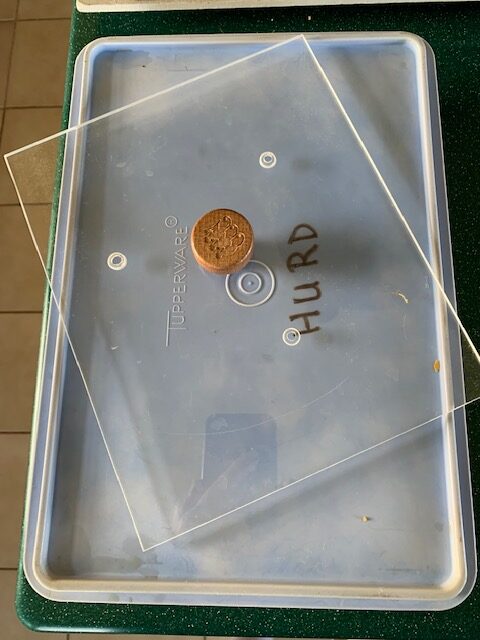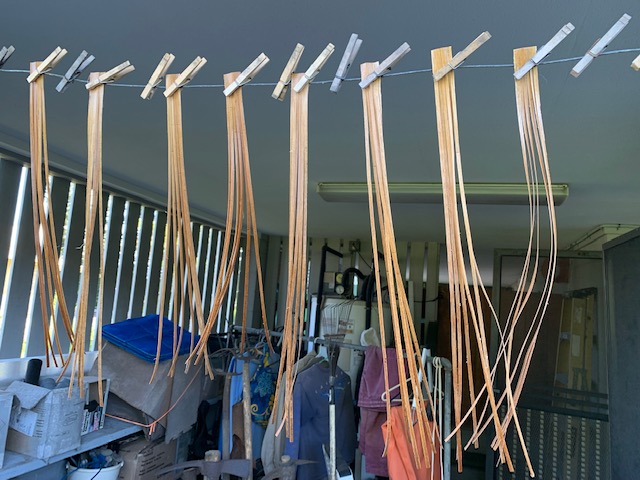Introduction
I think weʻve all had the experience when weaving of having to keep the strips or koana at just the right moisture level so that they remain flexible and “user friendly”. But the constant wetting and drying also seem to me to make the koana stiffer with time. And gradually those that have been compressed at an earlier step, now expand. Of course experience kumu ulana deal with this all the time and have little or no issues that they canʻt handle.
But if there were a way to keep the koana flexible all the way through the weaving without having to spray all the time, perhaps that would be helpful to the less experienced.
Glycerin is a colorless, odorless, viscous liquid that is sweet-tasting and non-toxic. A 10% glycerin solution in water has been used by several individuals ( 1, 2 ) for the purpose of softening cane before working with it to restore chair seats.
With that in mind, I began to experiment with using a 10% glycerin in water solution to soften lauhala strips (koana) before weaving. So far, over a period of several months, the results have been successful enough that I wanted share what Iʻve done with the general community.
Discussion
Pandanus leaves or lauhala share many of the general properties of most leaves. The upper surface of the lauhala is more resistant to water coming and going than the underside. Probably thatʻs one reason why lau curl inwards as they dry – the inner surface loses water faster than the outer one.
But I suggest that lauhala are cut into koana, the edges of these strips have other ways of gaining and losing water in addition to the stoma. And that would be the open spongy mesophyll layer as well as the xylem and phloem tubes. So it may be faster to absorb or exchange liquids from the sides of a cut leaf than from the top or bottom.
Given that, I suggest that you strip the lauhala into the widths that youʻll be using for your final product before putting them into the 10% glycerin solution.
Procedure
Where to buy the glycerin? If you need it right away, health food stores are one option. Materials there are generally more expensive so a better long term option might be Ebay using the search term vegetable glycerin. There are a lot of choices but ones which offer free shipping and reasonable prices, have high ratings and are manufactured in the US seem good. I suggest that you first start out with a pint or quart size to see if this approach works for you.
I generally begin the process with a gallon of the mixture. That means that you would begin with a little over 1 1/2 cups of glycerin and make that up to one gallon with tap water. Stir well.
What sort of container? You do want one with a cover. Iʻve used both one gallon glass or plastic jars and low, rectangular food containers and both work well. The food container below measures 8 1/2″ x 12 3/4″ x 2 3/4 “. I had a plexiglass sheet that was about 1/2-1” deep narrower than the width and length of the container which I use to weigh down the koana.
 Figure 1. 2 3/4″ deep plastic food container with plexiglass insert.
Figure 1. 2 3/4″ deep plastic food container with plexiglass insert.
Lately all the weaving Iʻve done is on hats. So for me that means using ~1/8″ wide koana. When I use the stripper, I leave the koana attached at the bottom of the lauhala as though I were going to start making a piko (Figure 2). This makes it easier to loosely roll them up before putting them in the solution and also for hanging them up to drip dry after soaking.
OK, so loosely roll up about 8 of the koana strips and put them in the solution, making sure that all the material is submerged ( with the plexiglass insert ) and also that the strips are not too closely packed together. I usually do this at the end of the day. The next morning, hang them up to drip dry. Clothes pins on wire work for me.
 Figure 2. Koana strips hanging out to drip dry.
Figure 2. Koana strips hanging out to drip dry.
After an hour or so wipe them down with an old towel. If itʻs a nice day (sunny) I put them out on a hard surface in the sunshine for several hours. If itʻs rainy or cloudy, I put them on a baking sheet in a 225 F oven for 20-25 minutes. You donʻt want them to be crispy dry but rather feel just slightly damp when youʻre done, so checking them every 5-10 minutes or so is a good approach until you get the feel.
After the soaking and drying process is a good time to carefully look at the koana. You may have earlier put them through a pasta roller to flatten them. But later on if/when you mist the koana with just water when working with them, the koana will swell again often to their original size! After the soaking and drying process using glycerin, there are no surprises because the koana which were originally thick are larger again. And that means that you can discard or shorten the ones that are too thick before you try to deal with them during the weaving process.
Like other weavers, before weaving I run each koana over my thumbnail several times on both sides to make sure that itʻs flexible for its whole length. This process also lets you feel inconsistencies in the koana that you might no see by casual inspection.
Donʻt be surprised if the solution changes color after several cycles of use. Iʻm not sure what chemicals within the koana are responsible for this but I donʻt sense koana color change from one batch to the next.
Recently Iʻve had the opportunity to work with red lauhala. The leaves that I have are much more leathery than most of the average lauhala. The 10% glycerin process makes the red lauhala much easier to work with compared to not having soaked them.
If youʻre not going to be doing the soaking process for several days, I suggest that you put the mixture in the fridge to slow down bacterial activity. Not doing so will allow them to continue and make the solution pretty smelly after a few days. It still works but…
Summary
This process is still a work in progress for me. But Iʻve made five complete hats using only treated koana and they remained pliable and easy to work with during the entire process. Not having to spray all the time and then dealing with problem koana has been a real bonus.